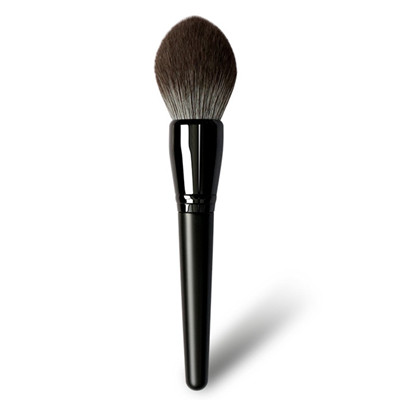Firstly is bristle material. Users in cold regions may be more concerned about the softness and moisturizing ability of the bristles. Animal hair brushes may become hard at low temperatures, while synthetic hair may be more suitable because synthetic fibers are better able to maintain elasticity at low temperatures. In addition, static electricity is also a problem. Static electricity is easily generated in a dry environment, resulting in flying powder or bristle adhesion, which requires antistatic treatment.
Then is handle material. Metal handles may feel even colder or even sticky in extreme cold conditions, so need to use insulating materials or coatings. Wooden handles are natural, but may crack in dry conditions and require special treatment.
The adaptability of moisturizing and nourishing products is also very important. Users in cold regions may use more oily or creamy products, and the bristles need to be easy to push these textures and easy to clean. Need to adjust the bristles density and elasticity to ensure that the product can be evenly dipped and released.
Portability and antifreeze design should not be ignored. Users may touch up their makeup outdoors, and the bristles need to be antifreeze to prevent them from becoming brittle and breaking at low temperatures. In terms of packaging, antifreeze materials may be required to prevent damage during transportation or storage.
In terms of cleaning and maintenance, water in cold regions may be colder, and a milder detergent may be needed when cleaning the brush to avoid damaging the bristles. It is also important to dry quickly to prevent any residual moisture from freezing.
Finally is regulatory and environmental requirement, such as meeting low-temperature testing standards, environmentally friendly and recyclable materials, and avoiding the release of harmful substances in extreme environments.
Bristle material and process optimization
1. Low temperature adaptability material
Preferred synthetic hair:
Choose cold-resistant nylon (such as Toray ultra-soft fiber, which remains elastic at -30℃)
Antistatic treatment:
Add graphene coating or antistatic agent to bristle surface (surface resistance <10⁹Ω), reduce the adhesion of flying powder to the bristles.
Choose cold-resistant nylon (such as Toray ultra-soft fiber, which remains elastic at -30℃)
Antistatic treatment:
Add graphene coating or antistatic agent to bristle surface (surface resistance <10⁹Ω), reduce the adhesion of flying powder to the bristles.
2. Compatibility with moisturizing products
Dense short hair design:
The length of the bristles is shortened by 20% (e.g. 8mm→6.5mm) to improve the grip of creamy/oily products (e.g. Fenty Beauty contouring brush).
Gradient hair transplantation technology:
The inner layer of dense hair is for powder collection, and the outer layer of long hair is for blending, which is suitable for thick powder cream (reference: Hourglass Vanish foundation brush).
The length of the bristles is shortened by 20% (e.g. 8mm→6.5mm) to improve the grip of creamy/oily products (e.g. Fenty Beauty contouring brush).
Gradient hair transplantation technology:
The inner layer of dense hair is for powder collection, and the outer layer of long hair is for blending, which is suitable for thick powder cream (reference: Hourglass Vanish foundation brush).
Brush handle and structural design
1. Antifreeze grip optimization
Material selection:
Aviation aluminum + silicone wrapping layer (such as Real Techniques ice series) to isolate metal from low temperature conduction.
Flax fiber composite plastic (such as Nordic brand Lumene), natural heat insulation and non-slip.
Ergonomic arc:
The thickened handle (diameter ≥ 2cm)with thumb groove, suitable for wearing gloves.
Aviation aluminum + silicone wrapping layer (such as Real Techniques ice series) to isolate metal from low temperature conduction.
Flax fiber composite plastic (such as Nordic brand Lumene), natural heat insulation and non-slip.
Ergonomic arc:
The thickened handle (diameter ≥ 2cm)with thumb groove, suitable for wearing gloves.
2. Sealed moisture-proof structure
Replaceable brush head system:
Add silicone sealing ring (such as Purobio) at the interface to prevent moisture from entering and causing rust on the metal tube mouth.
Retractable dust cover:
Built-in desiccant chamber (such as Artis Elite) to keep the bristles dry.
Add silicone sealing ring (such as Purobio) at the interface to prevent moisture from entering and causing rust on the metal tube mouth.
Retractable dust cover:
Built-in desiccant chamber (such as Artis Elite) to keep the bristles dry.
Product Support and User Experience
1. Low-temperature Cleaning Solution
Quick-drying Cleaning Liquid:
Provide an ethanol-free formula that can still flow at -20℃ (such as Cinema Secrets antifreeze).
Portable Drying Box:
Integrated PTC heating plate (5 minutes fast drying) to avoid natural drying and freezing.
Provide an ethanol-free formula that can still flow at -20℃ (such as Cinema Secrets antifreeze).
Portable Drying Box:
Integrated PTC heating plate (5 minutes fast drying) to avoid natural drying and freezing.
2. Customized user guide
Preheating tips:
The package includes a "brush preheating card" (apply it to the radiator for 10 seconds and then wipe the bristles to improve softness).
Antifreeze storage bag:
Aluminum foil insulation layer + fleece lining (such as Sigma Travel Kit),can protect the bristles in an outdoor environment of -30℃.
The package includes a "brush preheating card" (apply it to the radiator for 10 seconds and then wipe the bristles to improve softness).
Antifreeze storage bag:
Aluminum foil insulation layer + fleece lining (such as Sigma Travel Kit),can protect the bristles in an outdoor environment of -30℃.
Extreme environment testing standards
- Low temperature bending test: -40℃ frozen for 24h, the bristles are bent 180° for 10 times, without breaking or hair loss;
- Temperature difference cycle test: -30℃→25℃ alternating cycle 50 times (humidity 30%→80%), The brush handle has no cracks and the hair glue has no failure;
- Antistatic test: Mineral loose powder is used in a 15% humidity environment, The powder flying rate is less than 5% (industry average 15%);
- Antifreeze packaging test: Simulated -50℃ transportation for 72 hours, The bristle rebound rate is ≥90%, and the printing does not fall off.







